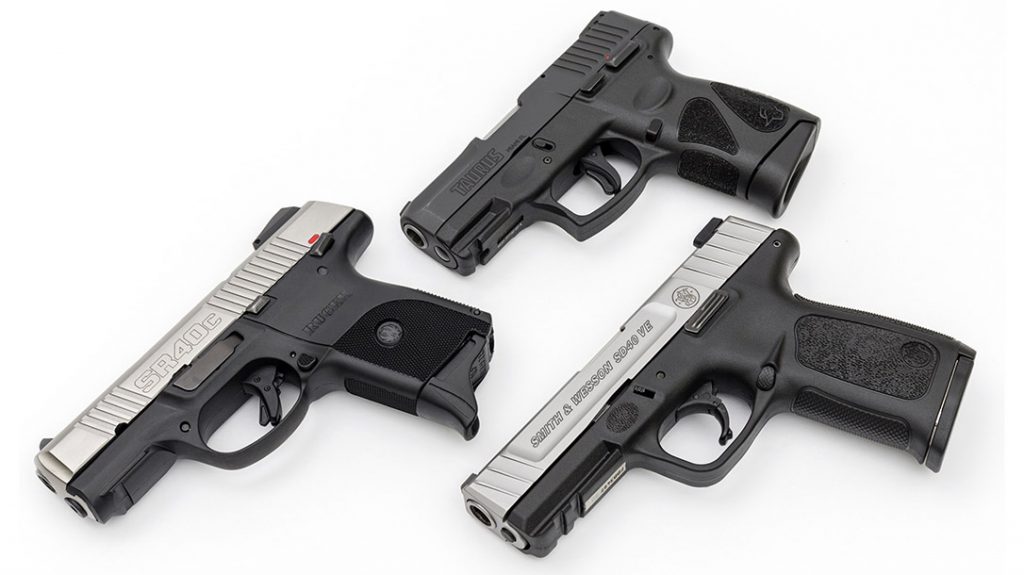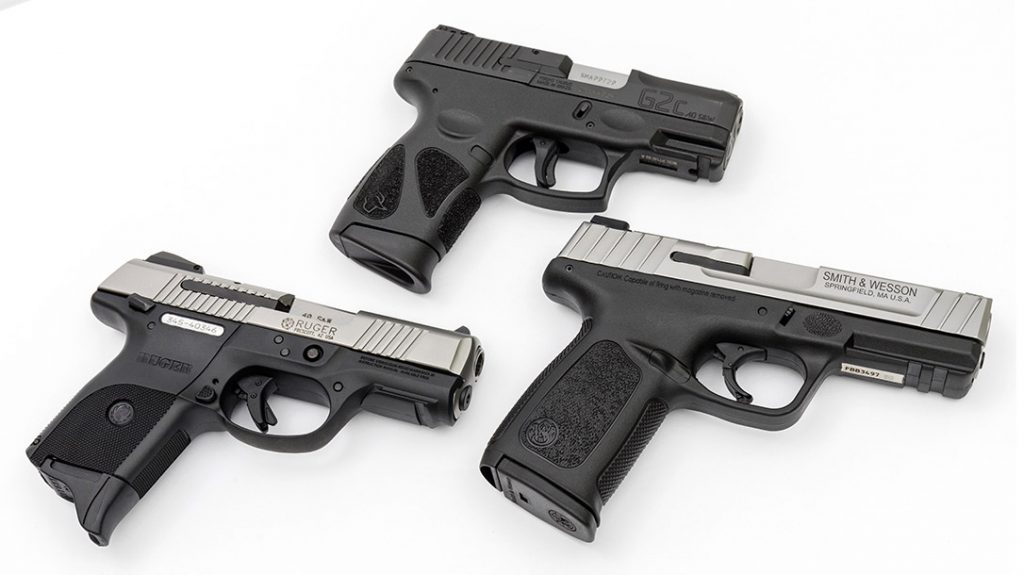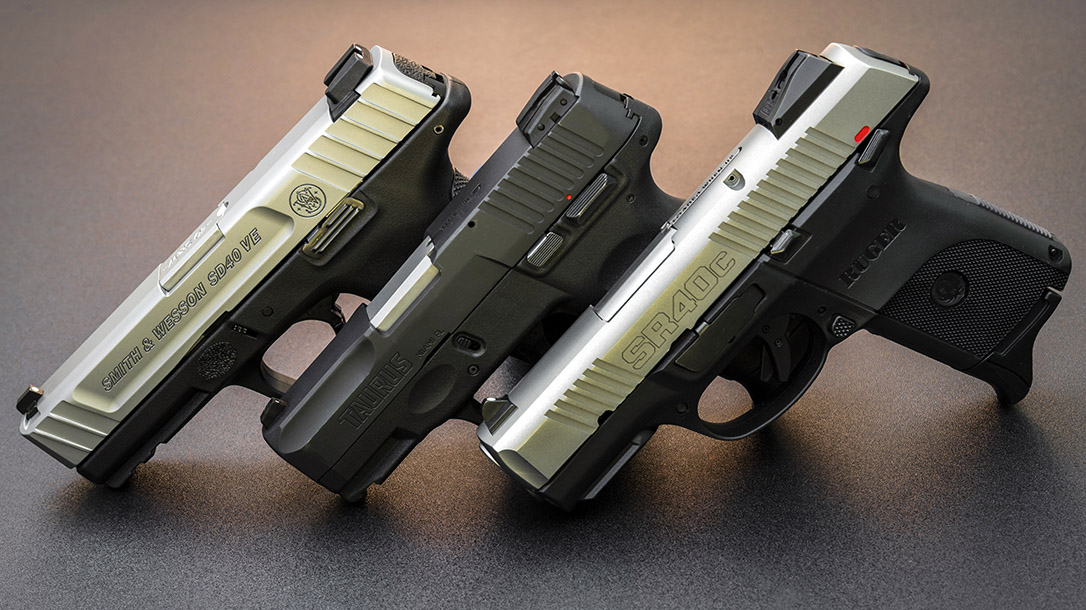It took me quite a while to warm up to the 40 S&W pistol and cartridge. I basically ignored it until my agency issued me a 40 pistol. As an experienced shooter, I wasn’t intimidated by the added recoil and muzzle flip that it displayed compared to the 9mm, but that didn’t hold true for everyone.
40 S&W Pistol Bargains
Lots of qualification scores went down, and remedial training went up. One officer who couldn’t qualify became an ex-officer. As bullet technology improved, performance differences between the 40 and the 9mm narrowed, and many agencies, beginning with the FBI, moved back to the 9mm. Does that make the 40 S&W a bad cartridge? No, but it’s not for everyone. Given its decline in law enforcement (LE) use and overall popularity, prices for guns and ammo have dropped, so “budget 40s” are out there waiting for consumers. This is not a side-by-side comparison, but an examination of the pluses and minuses they individually possess.
Ruger SR40c
This first pistol is almost a case in point. When I received the test gun late in 2018, it was still in the catalog. Now in 2019, it isn’t. However, it’s still out there in substantial numbers, and “street prices” are running about $200 below the MSRP of $525. The “c” is a compact version of the SR40, which was hailed as one of the slimmest and most ergonomic of service-size .40 pistols. It has a high-performance, glass-filled, black nylon frame, with a short trigger reach, ambidextrous controls (sans the slide stop) and a rubber overmolded reversible backstrap, giving you the option of a flat or arched rear surface. My duo-tone pistol has a brushed stainless steel slide and 3.5-inch barrel. The sights are three-dot with a sloping blade in front and an elevation-adjustable rear. Both sights come affixed in dovetails and move laterally for windage.
Advertisement — Continue Reading Below
A prominent loaded chamber indicator resides on top of the slide. Serrations are both up front and in back, and the ejection port is quite generous in size, as is the cartridge extractor. This is a striker-fired pistol, with no second-pull capability. Unlike many compact auto-loaders it does have a manual safety, which cannot be used unless the pistol is “cocked.” The grip portion of the frame is checkered on the sides and front, while the backstrap is serrated. The dust cover has an integral rail. Two magazines are provided with the SR40c: a 9-rounder with a finger-rest baseplate and a 15-rounder furnished with a grip extension sleeve.
Smith & Wesson SD40 VE
One of the most economical semi-autos made by S&W, the SR40 VE has an MSRP of $389 and street pricing as low as $299. An apparent offspring of the Sigma pistol introduced in 1994, the SD40 VE is striker-fired, with a Self Defense Trigger (SDT) for a consistent pull and no manual safety. It’s a medium-sized pistol with a 4-inch barrel and 7.2-inch overall length, but I found it was still fairly concealable. It has a 14+1 capacity, given its rather long double-stacked magazine. Two magazines are provided. The slide features satin-finished stainless steel, with wide front and rear serrations and stylish sculpting on the sides. A D-shaped cavity in the rear of the barrel serves as a loaded chamber indicator, and the gun has a huge ejection port. The fixed three-dot sights come mounted in dovetails, so they move laterally for windage.

Advertisement — Continue Reading Below
The black polymer frame and grip give the SR40 VE a duo-tone look. Just above the front portion of the triggerguard are textured, dished-out ovals where the trigger finger can rest. An accessory rail is built into the dust cover. Controls consist of a slide-stop latch and magazine catch on the left side only. The sides of the grip frame are textured, with front- and backstrap areas checkered. Ergonomically, the grip felt good in my hand, with the front somewhat rounded lengthwise and the rear slightly arched.
Taurus G2C
Smaller than the previous two pistols, the G2C was just recently introduced in the shorty 10mm cartridge. Starting with its most interesting feature, the striker-fired pistol has a safe-action-type trigger with “restrike” capability. In other words, if the trigger is pulled on a loaded chamber and the round doesn’t go off, you can pull the trigger again. This makes for a very interesting trigger pull feel and audible click as the trigger is pressed to the rear for the first shot. It has the feel of a trigger on toy cap guns I used to play with as a kid, but don’t take this as a put-down.
My test pistol had a flat black carbon steel slide and black polymer frame and grip. The smallest of the three test guns, its barrel is 3.2 inches long, and the overall length is only 6.3 inches. On the topside, the slide has three-dot sights, the front fixed, while the rear is fully adjustable, affixed in a dovetail.
Advertisement — Continue Reading Below
At the rear of the ejection port is a loaded chamber indicator. Serrations are located on the rear of the slide, while the front portion is fluted. A rail is built into the dust cover of the frame, as are oval finger locators. Controls are on the left side and include a slide-stop latch, thumb safety and magazine catch. The grip portion of the frame has textured panels all around, and the base of the 10-round magazine has a finger rest. Two identical blue steel magazines are provided.
Ammo Selection
Right now (near 2020 Halloween), there’s a lot of 40 S&W ammo still out there. Many LE agencies haven’t abandoned it yet, nor have lots of armed citizens. Searching the Internet, I find most of the practice cartridges with full metal jacket (FMJ) bullets run 18.3 to 23.2 cents per round. Defense ammo with JHP and other bullet designs can generally be had for around $20 for a 20- or 25-round box. To shoot in my “budget 40” pistols, I chose five different brands of jacketed hollow-point (JHP)-type cartridges.
From Black Hills, I obtained their factory new 140-grain Barnes TAC-XP hollow-point cartridges. DoubleTap provided their heavy-duty 200-grain JHP load. Hornady sent their Critical Defense cartridges, which feature a 175-grain FlexLock bullet with a red synthetic “plug” in the hollow nose cavity that makes the bullet “barrier blind” yet allows expansion. Remington supplied their Golden Saber Black Belt 180-grain brass-jacketed HP that has the Mechani-Lokt Belt to secure the lead core within the bullet jacket. Finally, from Speer came their LE G2 cartridges that feature their 180-grain Gold Dot HP, which also has a capped nose cavity.
Advertisement — Continue Reading Below
Carrying Options
I went through my holster and accoutrements collection to search for the elusive holster that would satisfactorily fit all three of my “budget 40” handguns. A holster that was inexpensive, would fit well enough to secure the guns, yet allow a smooth presentation and reholstering. As the goal was to find a rig with concealed carry applications, I didn’t necessarily want a scabbard with any kind of retention safety strap or other such device, just a high-ride, open-top shuck.
The holster that ended up fulfilling these requirements was a well-used Uncle Mike’s Super Belt Slide in black nylon. I also wanted a single magazine pouch that would work with all the various magazines, and the one I picked was a paddle-back, black synthetic belt model from Fobus. It has a friction retention device inside that provided a secure hold for all the magazines. These were all threaded onto a Nexbelt “no holes” black ballistic nylon, 1.25-inch-wide tactical belt.
Downrange
Range day started out with firing all the test loads through the three test pistols to get velocity readings. Given the barrel lengths and bullet weights, I wasn’t expecting too many four-figure measurements. Naturally the 4-inch barrel of the S&W pistol got the high marks.
Advertisement — Continue Reading Below
Accuracy potential was evaluated by shooting three five-shot groups at 15 yards using the three “budget 40” pistols. This distance was chosen due to barrel length, trigger action and sight considerations. A sandbag rest was used on a solid bench, and yours truly did all the shooting, my 64-year-old eyes assisted by some bifocal shooting glasses. Shots were fired one after the other, with no long waits between shots, for what I consider a more realistic assessment. The best groups and even average groups were pretty darn good, with none making it over the 3-inch line. Point of aim/point of impact was adjusted for each gun considering the barrel length, sights and bullet weight.
Testing the 40s
All three test guns were shot using a 30-round combat qualification course that I once used as a federal LEO. All five of the 40 S&W test cartridges were randomly mixed in the magazines. The pistols were all shot until empty and a magazine change was required. To keep old habits fresh, between stages or before the guns were reholstered, I did a 360-degree threat assessment, working the gun slowly back into the holster.
Before beginning, I added the Uncle Mike’s holster and Fobus mag pouch onto my Nexbelt tactical belt. The shooting came after presenting the gun from the holster. As with the accuracy testing, I basically shot the guns in alphabetical order. Shooting began at 3 yards, single-hand-only, first right, then left, point-shoulder shooting, six rounds with each hand. Moving back to 7 yards, a series of three double-taps were fired, using the sights and a two-handed hold. Also at 7 yards, I shot a failure drill: two shots center mass and one to the head. This was done twice. At 15 yards, I shot behind a barricade, two shots left side standing, two shots right side standing and two shots right side kneeling.
Advertisement — Continue Reading Below
The Nitty Gritty
The Ruger SR40c scored 282/300 (4Xs) points, with most of the shots going into the upper region of the scoring rings and to the right. This was pretty much the same point of aim/impact as when shooting for accuracy. The ergonomics on this pistol are very good, and the shot grouping on the B-27 target was the smallest of the three guns. It handled the recoil and muzzle flip well. The sights came up on target fast and were easy to see during bullseye-type shooting.
Guns That Run
There were zero malfunctions, but the full-sized magazine with the grip extension sleeve sometimes wanted to catch on the heel of my shooting hand when ejecting the mag. The slide on this gun just looks oversized, and it’s actually the heaviest of the three pistols. The shark fin-shaped front sight is high, perhaps so the shooter can see over the humongous loaded chamber indicator. And the rear sight is also too high and too big, in my opinion. I’d rather have more low-profile, fixed sights. I never used the tiny manual safety, preferring to forget it was there.

Advertisement — Continue Reading Below
The S&W SD40 VE came up with 284/300 (6Xs) points on the B-27 target. This gun, of course, had the longest barrel, sighting radius and grip frame. The shots dispersed in the central area of the target, but both head shots were low and to the left, and one center-mass shot landed at 7 o’clock in the 8-ring. Meanwhile, the S&W tended to shoot slightly left of center during the accuracy test, but elevation was okay. The S&W was not the accuracy winner of the three guns, and the reason was the SDT trigger. The pull measured consistently heavy, and I wondered at times when the sear would release. This was not so noticeable when combat shooting.
Rounds Downrange
The gun had great, easy-to-see sights, had zero malfunctions during the entire test and dropped the empty magazines just fine. The few controls were easy to manipulate. Its size and grip configuration guaranteed that it remained controllable in rapid-fire shooting. Its about the same size as the Glock 19/23, which I have never found difficult to carry and conceal.
The Taurus G2C won the B-27 shooting contest with 290/300 (12Xs) points. No shots escaped out into the 8-ring, and the 9s and 10/Xs all hit well centered. The Taurus has a slight leg up on the other two 40s in the accuracy department, despite its 3.2-inch barrel and shorter sighting radius. I mentioned the strange two-stage, re-strike trigger earlier. But when it came down to brass tacks, it really didn’t hamper my shooting. Unfortunately, the not-so-liked aspects of this pistol included some feed ramp jams during the accuracy test. However, it was only with one brand of cartridges, which is an easy fix. The front sight is a Bill Bell no-no: plastic. The rear sight had tiny white dots, and I’d trade the adjustment feature for something fixed, maybe Novak-style.
Advertisement — Continue Reading Below
I found the magazine catch too small for positive manipulation. It translated into the magazine failing to drop out upon pressing. It was the only one of the three pistols that wouldn’t allow the slide to come forward with an empty magazine in place. Like the Ruger, the Taurus had a thumb safety, which I also ignored, but it was bigger and easier to flip on and off.
Final Thoughts
So, there you have it, gentle readers: three of the most economically priced handguns on today’s market, in the effective but increasingly unpopular 40 S&W cartridge. The results are what they are, with each handgun showing certain strengths and weaknesses. Any will serve as a good everyday carry (EDC) pistol. You just have to pick the combination of size, weight and configuration that is most compatible with your individual wants and needs.
40 S&W Pistol Specs
| Ruger SR40c | S&W SD40 VE | Taurus G2C | |
| Overall Length | 6.84 inches | 7.20 inches | 6.30 inches |
| Weight | 23.4 ounces | 22.4 ounces | 22 ounces |
| Grip | nylon | polymer | polymer |
| Sights | 3-dot | three-dot | 3-dot |
| Action | Striker-fired | Also Striker-fired | Also Striker-fired |
| Finish | Stainless slide | Stainless slide | Matte black |
| Barrel | 3.50 inches | 4 inches | 3.20 inches |
| Capacity | 9+1/15+1 | 14+1/10+1 | |
| MSRP | $525 | $389 | $317 |
40 S&W Pistol Performance
| Ruger | SR40c | S&W | SD40 VE | Taurus | G2C | |
| Velo | Accuracy | Velo | Accuarcy | Velo | Accuarcy | |
| Black Hills 140 TAC-XP | 1,071 | 2.19 | 1,081 | 2.79 | 1,057 | 2.22 |
| DoubleTap 200 JHP | 945 | 2.23 | 1,004 | 2.59 | 971 | 2.48 |
| Hornady CD 175 Flexlock | 928 | 2.91 | 952 | 2.77 | 925 | 2.51 |
| Remington BB 18 GSHP | 909 | 2.36 | 955 | 2.76 | 916 | 1.91 |
| Speer LE G2 18 GDHP | 907 | 2.81 | 926 | 2.61 | 901 | 2.01 |
This article is from the March-April 2021 issue of Combat Handguns magazine. Grab your copy at OutdoorGroupStore.com.
























